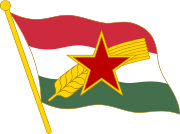Hungarian Working People's Party Magyar Dolgozók Pártja | |
|---|---|
 | |
| First leader | Mátyás Rákosi |
| Last leader | János Kádár |
| Founded | 12 June 1948 |
| Dissolved | 31 October 1956 |
| Merger of | MKP MSZDP |
| Succeeded by | MSZMP |
| Newspaper | Szabad Nép |
| Ideology | |
| Political position | Far-left |
| National affiliation | Patriotic People's Front |
| International affiliation | Cominform (1948-1956) |
| Party flag | |
 | |
The Hungarian Working People's Party (Hungarian: Magyar Dolgozók Pártja, abbr. MDP) was the ruling communist party of Hungary from 1948 to 1956.
It was formed by a merger of the Hungarian Communist Party (MKP) and the Social Democratic Party of Hungary (MSZDP).[1] Ostensibly a union of equals, the merger had actually occurred as a result of massive pressure brought to bear on the Social Democrats by both the Hungarian Communists, as well as the Soviet Union. The few independent-minded Social Democrats who had not been sidelined by Communist salami tactics were pushed out in short order after the merger, leaving the party as essentially the MKP under a new name. Its leader was Mátyás Rákosi until 1956, then Ernő Gerő in the same year for three months, and eventually János Kádár until the party's dissolution. Other minor legal Hungarian political parties were allowed to continue as independent coalition parties until late 1949 but were completely subservient to the MDP.
During the Hungarian Revolution of 1956, the party was reorganized into the Hungarian Socialist Workers' Party (MSZMP) by a circle of communists around Kádár and Imre Nagy. The new government of Nagy declared to assess the uprising not as counter-revolutionary but as a "great, national and democratic event" and to dissolve State Security Police (ÁVH). Hungary's declaration to become neutral and to exit the Warsaw Pact caused the second Soviet intervention on 4 November 1956. After 8 November 1956, the MSZMP, under Kádár's leadership, fully supported the Soviet Union.

YouTube Encyclopedic
-
1/5Views:4 4236286 90695 755108 484
-
7th Congress Of The Hungarian Socialist Workers' Party (1950-1959)
-
RAKOSI "Report to the Second Congress of the Hungarian Working Peoples Party" [Full audiobook]
-
The Second Hungarian Republic (1946–1949) – How Hungary Became Communist After WW2
-
Hungary Before the Revolution of 1956
-
How Hungary Almost Beat the USSR
Transcription
Leaders of the Hungarian Working People's Party
General/First Secretaries
| No. | Picture | Name (Birth–Death) |
Term of Office | Position(s) | |
|---|---|---|---|---|---|
| 1 | 
|
Mátyás Rákosi (1892–1971) |
12 June 1948 | 18 July 1956 | General Secretary |
| First Secretary (from 28 June 1953) | |||||
| 2 | 
|
Ernő Gerő (1898–1980) |
18 July 1956 | 25 October 1956 | |
| 3 | 
|
János Kádár (1912–1989) |
25 October 1956 | 31 October 1956 | |
Chairman
| No. | Picture | Name (Birth–Death) |
Term of Office | Notes | |
|---|---|---|---|---|---|
| 1 | 
|
Árpád Szakasits (1888–1965) |
12 June 1948 | 24 April 1950 | Also President (1948–1949) and Chairman of the Presidential Council (1949–1950) |
Electoral history
National Assembly elections
| Election | Party leader | Votes | % | Seats | +/– | Position | Government |
|---|---|---|---|---|---|---|---|
| 1949 | Mátyás Rákosi | as part of Patriotic People's Front | 285 / 402
|
Sole legal party | |||
| 1953 | 206 / 298
|
Sole legal party | |||||
See also
References
- ^ Neubauer, John, and Borbála Zsuzsanna Török. The Exile and Return of Writers from East-Central Europe: A Compendium. New York: Walter de Gruyter, 2009. p. 140
